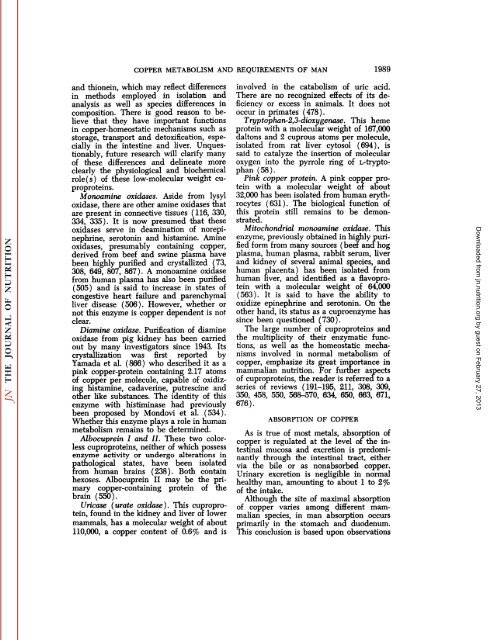conspectus of researchon copper metabolism and requirements
conspectus of researchon copper metabolism and requirements
conspectus of researchon copper metabolism and requirements
Create successful ePaper yourself
Turn your PDF publications into a flip-book with our unique Google optimized e-Paper software.
COPPER METABOLISM AND REQUIREMENTS OF MAN 1989<br />
<strong>and</strong> thionein, which may reflect differences<br />
in methods employed in isolation <strong>and</strong><br />
analysis as well as species differences in<br />
composition. There is good reason to be<br />
lieve that they have important functions<br />
in <strong>copper</strong>-homeostatic mechanisms such as<br />
storage, transport <strong>and</strong> detoxification, espe<br />
cially in the intestine <strong>and</strong> liver. Unques<br />
tionably, future research will clarify many<br />
<strong>of</strong> these differences <strong>and</strong> delineate more<br />
clearly the physiological <strong>and</strong> biochemical<br />
role(s) <strong>of</strong> these low-molecular weight cuproproteins.<br />
Monoamine oxidases. Aside from lysyl<br />
oxidase, there are other amine oxidases that<br />
are present in connective tissues (116, 330,<br />
334, 335). It is now presumed that these<br />
oxidases serve in deamination <strong>of</strong> norepinephrine,<br />
serotonin <strong>and</strong> histamine. Amine<br />
oxidases, presumably containing <strong>copper</strong>,<br />
derived from beef <strong>and</strong> swine plasma have<br />
been highly purified <strong>and</strong> crystallized (73,<br />
308, 649, 807, 867). A monoamine oxidase<br />
from human plasma has also been purified<br />
(505) <strong>and</strong> is said to increase in states <strong>of</strong><br />
congestive heart failure <strong>and</strong> parenchymal<br />
liver disease (506). However, whether or<br />
not this enzyme is <strong>copper</strong> dependent is not<br />
clear.<br />
Diamine oxidase. Purification <strong>of</strong> diamine<br />
oxidase from pig kidney has been carried<br />
out by many investigators since 1943. Its<br />
crystallization was first reported by<br />
Yamada et al. (866) who described it as a<br />
pink <strong>copper</strong>-protein containing 2.17 atoms<br />
<strong>of</strong> <strong>copper</strong> per molecule, capable <strong>of</strong> oxidiz<br />
ing histamine, cadaverine, putrescine <strong>and</strong><br />
other like substances. The identity <strong>of</strong> this<br />
enzyme with histiminase had previously<br />
been proposed by Mondovi et al. (534).<br />
Whether this enzyme plays a role in human<br />
<strong>metabolism</strong> remains to be determined.<br />
Albocuprein I <strong>and</strong> II. These two color<br />
less cuproproteins, neither <strong>of</strong> which possess<br />
enzyme activity or undergo alterations in<br />
pathological states, have been isolated<br />
from human brains (238). Both contain<br />
hexoses. Albocuprein II may be the pri<br />
mary <strong>copper</strong>-containing protein <strong>of</strong> the<br />
brain (550).<br />
Uncase (urate oxidase}. This cuproprotein,<br />
found in the kidney <strong>and</strong> liver <strong>of</strong> lower<br />
mammals, has a molecular weight <strong>of</strong> about<br />
110,000, a <strong>copper</strong> content <strong>of</strong> 0.6% <strong>and</strong> is<br />
involved in the catabolism <strong>of</strong> uric acid.<br />
There are no recognized effects <strong>of</strong> its de<br />
ficiency or excess in animals. It does not<br />
occur in primates (478).<br />
Tryptophan-2,3-dioxygenase. This heme<br />
protein with a molecular weight <strong>of</strong> 167,000<br />
daltons <strong>and</strong> 2 cuprous atoms per molecule,<br />
isolated from rat liver cytosol (694), is<br />
said to catalyze the insertion <strong>of</strong> molecular<br />
oxygen into the pyrrole ring <strong>of</strong> L-tryptophan<br />
(58).<br />
Pink <strong>copper</strong> protein. A pink <strong>copper</strong> pro<br />
tein with a molecular weight <strong>of</strong> about<br />
32,000 has been isolated from human erythrocytes<br />
(631). The biological function <strong>of</strong><br />
this protein still remains to be demon<br />
strated.<br />
Mitochondrial monoamine oxidase. This<br />
enzyme, previously obtained in highly puri<br />
fied form from many sources (beef <strong>and</strong> hog<br />
plasma, human plasma, rabbit serum, liver<br />
<strong>and</strong> kidney <strong>of</strong> several animal species, <strong>and</strong><br />
human placenta) has been isolated from<br />
human liver, <strong>and</strong> identified as a flavoprotein<br />
with a molecular weight <strong>of</strong> 64,000<br />
(563). It is said to have the ability to<br />
oxidize epinephrine <strong>and</strong> serotonin. On the<br />
other h<strong>and</strong>, its status as a cuproenzyme has<br />
since been questioned (730).<br />
The large number <strong>of</strong> cuproproteins <strong>and</strong><br />
the multiplicity <strong>of</strong> their enzymatic func<br />
tions, as well as the homeostatic mecha<br />
nisms involved in normal <strong>metabolism</strong> <strong>of</strong><br />
<strong>copper</strong>, emphasize its great importance in<br />
mammalian nutrition. For further aspects<br />
<strong>of</strong> cuproproteins, the reader is referred to a<br />
series <strong>of</strong> reviews (191-195, 211, 308, 309,<br />
350, 458, 550, 568-570, 634, 650, 663, 671,<br />
676).<br />
ABSORPTION OF COPPER<br />
As is true <strong>of</strong> most metals, absorption <strong>of</strong><br />
<strong>copper</strong> is regulated at the level <strong>of</strong> the in<br />
testinal mucosa <strong>and</strong> excretion is predomi<br />
nantly through the intestinal tract, either<br />
via the bile or as nonabsorbed <strong>copper</strong>.<br />
Urinary excretion is negligible in normal<br />
healthy man, amounting to about 1 to 2%<br />
<strong>of</strong> the intake.<br />
Although the site <strong>of</strong> maximal absorption<br />
<strong>of</strong> <strong>copper</strong> varies among different mam<br />
malian species, in man absorption occurs<br />
primarily in the stomach <strong>and</strong> duodenum.<br />
This conclusion is based upon observations<br />
Downloaded from<br />
jn.nutrition.org<br />
by guest on February 27, 2013
















